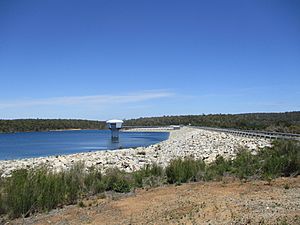North Dandalup Dam facts for kids
Quick facts for kids North Dandalup Dam |
|
|---|---|

The dam seen from the northern lookout point
|
|
| Country | Australia |
| Coordinates | 32°31′03.61″S 116°00′59.04″E / 32.5176694°S 116.0164000°E |
The North Dandalup Dam is a large wall built across a river in Western Australia. It's about 64 kilometers south of Perth, nestled in the Darling Scarp hills. This dam was built in 1994 and officially opened by the state's leader, Richard Court, that October. It was the last one in a series of dam projects, which also included the Victoria and Conjurunjup Dams.
The Water Corporation says this dam is a really important source of drinking water for a huge system called the Integrated Water Supply System (IWSS). It provides water to cities like Perth, Mandurah, Pinjarra, Harvey, and even the Goldfields region. It also supplies water for farming. In the past, it provided about 10% of Perth's yearly water supply.
Contents
Dam Capacity and Size
This dam project cost about $50 million. It can hold a massive 75 gigalitres[convert: unknown unit] of water. The most water it ever held was 59.85% of its full capacity in 1996. In 2011, it reached a low of 16.39%.
The area where the dam collects water, called its catchment area, is 153 square kilometers[convert: unknown unit]. When the dam is completely full, the surface of the water covers 510 hectares[convert: unknown unit]. As of 2009, the dam system could provide 22 gigalitres[convert: unknown unit] of water each year. This was an increase from 19 gigalitres[convert: unknown unit] per year in 2005.
Main Dam Structure
The main part of the dam is 62 meters (203 ft) high, which is like a 20-story building! It stretches 192 meters (630 ft) long.
Other Dams and Fun Areas
Besides the main dam, there are two smaller earth-filled dams nearby. These are on low hills to the northwest. The bigger one is 22 meters (72 ft) high, and the smaller one is 9 meters (30 ft) high.
Between these two smaller dams, there's a special lookout point. From here, you can see amazing views of Mandurah, the Peel Inlet, and the vast Indian Ocean. There's also an older dam, called the original Pipehead dam, which was built in 1971. This area is now open for people to visit and enjoy. It has cool facilities like barbecues, toilets, picnic tables, and parking spots.
Local Environment
Plants and Animals
The land around the North Dandalup Dam is home to many different plants and animals. The main trees you'll see are jarrah (Eucalyptus marginata), marri (E. calophylla), and wandoo (E. wandoo). You might also spot animals like kookaburras, long-billed cockatoos, and the bright red Scarlet Robin.
Rocks and Landforms
The dam is built on a very old part of the Earth's crust called the Archaean Yilgarn block. This area is mostly made of granitoid rock, which is a type of igneous rock. It also has dolerite dykes, which are like walls of rock that cut through other rock layers. The top layer of the ground is covered with laterite, a reddish soil rich in iron and aluminum.
Water Quality and Safety
The Water Corporation regularly checks the water quality in the dam. Studies have shown that the water has very low levels of metals and other inorganic substances. The only pesticide found, called Simazine, was present in only one sample. Even then, its level was much lower than what is considered safe for drinking water by Australian guidelines.
A 2005 plan by the Department of Environment also looked at possible risks to the water. The biggest concern was pathogen contamination, which means tiny germs that can make people sick. Other risks included turbidity (cloudy water), pesticides, and too many nutrients. While pathogens were the most serious risk, turbidity was the most likely to happen.
Before the water is sent to the Integrated Water Supply System (IWSS), it goes through an important cleaning process. First, it's disinfected using chlorine to kill germs. Then, fluoride is added. Scientists test the water for microbes (tiny living things) every week or month, depending on the time of year. This helps make sure the water is always safe to drink.
| Parameter | Units | Health Value Guideline | North Dandalup Pipeline Dam | |
|---|---|---|---|---|
| Range | Median | |||
| Metals | ||||
| Barium | mg/L | 0.7 | 0.015-0.018 | 0.016 |
| Boron | mg/L | 4 | 0.02-0.03 | 0.02 |
| Inorganics | ||||
| Nitrate + Nitrite (as N) | mg/L | 11.3 | 0.004-0.1 | 0.016 |
| Pesticides | ||||
| Simazine | mg/L | 20 | No detection - 0.3 | No detection |

